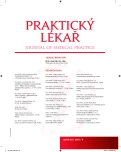Use of the indirect radionuclide uroflowmetry
Authors:
D. Chroustová 1; I. Urbanová 2; D. Palyzová 3; M. Šindelářová 1
Authors‘ workplace:
Ústav nukleární medicíny 1. LF UK a VFN, Praha Přednosta prof. MUDr. Martin Šámal, DrSc.
1; Dětské oddělení FN Na Bulovce, Praha Primář: MUDr. Ivan Peychl
2; Klinika dětí a dorostu 3. LF UK a FNKV, Praha Přednosta: doc. MUDr. Felix Votava, Ph. D.
3
Published in:
Prakt. Lék. 2013; 93(4): 152-157
Category:
Reviews
Overview
Radionuclide uroflowmetry (UFM) belongs to the spectrum of radionuclide investigative methods used in pediatric nephro-urological practice. We present results of the functional parameters by the evaluation of indirect radionuclide UFM in our group of patients with different nephro-urological diagnoses.
310 examinations were performed in 266 patients (67 boys and 199 girls aged 1.7 to 21 years, average age 10.6 years), 28 of them were examined repeatedly. All children were divided into groups by diagnosis: vesico-ureteric reflux (VUR), dysfunctional voiding, enuresis, urethral stenosis, follow-up after acute pyelonefritis (APN), recurrent urinary tract infection (UTI) and others. Indirect radionuclide UFM was done in the time range (45–80 minutes) after 99mTc-MAG3 dynamic renal scintigraphy using planar gammacamera MB 9200 (Gamma Budapest) provided with parallel HR collimator. Data acquisition: a dynamic study -1frame/sec, total time of the study –180 seconds, 128 × 128 matrix, ZOOM according to the size of the child.
Evaluation of the indirect radionuclide UFM was done using Ostnucline software which was focused mainly on determining the values of the functional parameters: a full bladder volume, a voided volume, a residual urinary bladder volume, a maximum flow rate, an average flow rate, a duration of the voiding, a maximum UFM index, an average UFM index.
In the group with suspected VUR, 8/17 children were detected with active VUR. In the group of children following VUR surgery, small bladder filling was the most frequent finding. Similarly, low volume of the bladder was detected in half of children with enuresis. Slow flow rate of micturition was recorded in all groups, most often in patients with dysfunctional voiding. Increased urinary residue after micturition was found in patients with recurrent UTI. The advantages and limits of this method are discussed in this study.
Based on our experience, despite the pitfalls of the method, indirect radionuclide UFM can provide valuable information indicative of pathological micturition or urinary tract pathology. The examination is simple, without any other radiopharmaceutical application, using the physiological conditions of filling and spontaneous emptying of the urinary bladder. A condition of the examination is the patient's cooperation.
Keywords:
indirect radionuclide uroflowmetry – functional parameters – childhood
Sources
1. Lim R. Vesicoureteral reflux and uronary tract infection: Evolving practices and current controversies in pediatric imaging AJR 2009; 192: 1197–1208.
2. Fettich J, Colarinha P, Fischer S, et al. Guidelines for standard and diuretic renogram in children [online]. Paediatric Committee of the European Association of Nuclear Medicine 2002. Dostupné na: www.eanm.org/publications/guidelines/gl_paed_sdr.pdf.
3. Gordon I, Colarinha P, Fettich J, et al. Guidelines for indirect radionuclide cystography [online]. Paediatric Committee of the European Association of Nuclear Medicine 2000. Dostupné na: www.eanm.org/publications/guidelines/gl_paed_irc.pdf.
4. Treves ST, Baker A, Fahey FH. et al. Nuclear medicine in the first year of life. J Nucl Med 2011; 52(6): 905–925.
5. Boubaker A, Prior JO, Meuwly JY, Bischof-Delaloye A. Radionuclide investigations of urinary tract in the era of multimodality imaging. J Nucl Med 2006; 47(11): 1819–1836.
6. Bashir H, Anderson PJ, Biassoni L, et al. Indirect radionuclide cystography in children – A review of practice and experience. Eur J Nucl Med Mol Imaging 2007; 34(Suppl 2): S250.
7. Vlajkovič M, Ilič S, Bogičevič M, et al. Radionuclide voiding patterns in children with vesicoureteral reflux. Eur J Nucl Med Mol Imaging 2003; 30(4): 532–537.
Labels
General practitioner for children and adolescents General practitioner for adultsArticle was published in
General Practitioner

2013 Issue 4
Most read in this issue
- Chloroquine retinopathy: case report and recommendations for screening
- The female and the male brain
- Dengue fever
- Nutritional imunology: modulation of immunity by components of nutrition
